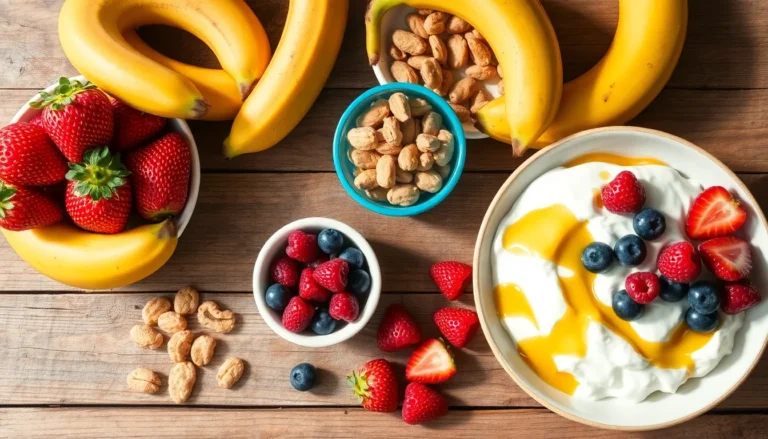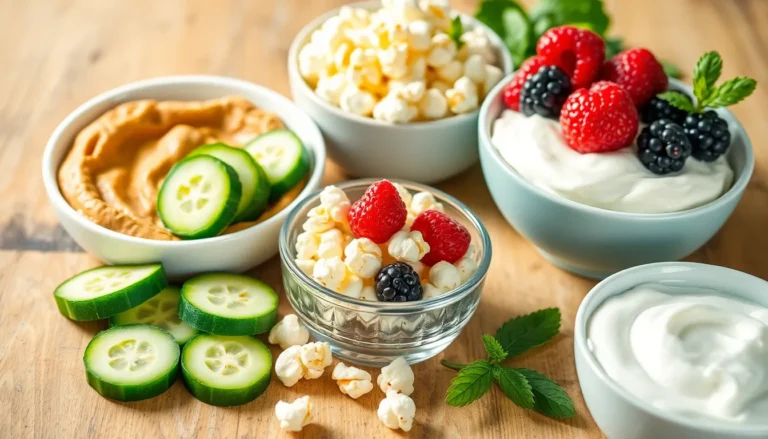Table of Contents
ToggleIn a world where kale reigns supreme and guilt-free indulgence feels like a myth, low-fat recipes are the culinary superheroes we didn’t know we needed. They swoop in to save the day, proving that healthy eating doesn’t have to be bland or boring. With a sprinkle of creativity and a dash of flavor, these recipes make it easy to enjoy delicious meals without the extra calories.
Overview of Low-Fat Recipes
Low-fat recipes prioritize health without compromising taste. These dishes often utilize fresh ingredients, herbs, and spices, enhancing flavor while reducing fat content. Substitutes for high-fat components include yogurt, avocado, and whole grains, making meals more nutritious.
Many low-fat recipes cater to diverse dietary preferences. Options include vegetarian, vegan, and even gluten-free dishes. Each recipe maintains the essence of traditional cooking while cutting down on unnecessary calories.
Cooking methods can also enhance the appeal of low-fat meals. Techniques such as grilling, baking, steaming, and sautéing often preserve nutrients and flavor. By avoiding frying, recipes maximize health benefits and minimize additional fats.
Grocery shopping for low-fat ingredients is straightforward. Fresh fruits, vegetables, lean meats, and whole grains represent common options. Planning meals around seasonal produce can offer variety and maintain interest.
Nutritional balance is key when creating low-fat dishes. Combining proteins, carbohydrates, and healthy fats ensures satisfaction and fullness. Incorporating legumes, nuts, and seeds provides essential nutrients and significant flavor profiles.
Meal prep simplifies daily cooking. Preparing low-fat meals in advance saves time and helps maintain a healthy diet. Freezing portions for later use allows for convenient, quick dishes during busy weeks.
Overall, low-fat recipes serve as versatile options, promoting healthier eating habits. Emphasizing creativity in cooking, they prove that healthy eating can indeed be delightful.
Benefits of Low-Fat Cooking

Low-fat cooking offers numerous advantages that enhance health and satisfaction. Focusing on nutritious ingredients promotes a balanced diet without sacrificing flavor.
Health Advantages
Low-fat meals incorporate fresh fruits, vegetables, and whole grains, which contribute essential vitamins and minerals. By reducing saturated fats, these recipes lower the risk of heart disease, improve cholesterol levels, and support overall wellbeing. Nutrient-rich herbs and spices also play a key role in flavor enhancement. Using substitutes, such as yogurt instead of cream, retains taste while minimizing calories. Cooking methods like grilling and steaming preserve the nutrients in ingredients, making meals healthier. Low-fat diets encourage better digestive health and provide energy, making them a beneficial choice for overall health.
Weight Management
Low-fat recipes assist with weight management by reducing calorie intake while still offering tasty meals. Satiating meals that are lower in fat encourage portion control and might contribute to weight loss. Substituting high-fat ingredients with lean proteins and healthy fats promotes a feeling of fullness without excess calories. Furthermore, incorporating whole grains provides fiber, which aids in digestion and curbs hunger. Balanced meals featuring proteins, carbs, and healthy fats create stability in energy levels, making it easier to maintain a healthy weight. Low-fat cooking emphasizes satisfaction through nutritious options, turning healthy meals into enjoyable experiences.
Popular Ingredients in Low-Fat Recipes
Low-fat recipes often rely on a selection of ingredients that enhance flavor while keeping fat content low. Various options exist to create delicious meals without compromising health.
Lean Proteins
Lean proteins provide essential nutrients without adding excess fat. Chicken breast, turkey, and fish are popular sources. Additionally, legumes like beans and lentils serve as excellent vegetarian alternatives. Incorporating these proteins into meals promotes muscle health and aids in weight management, making them suitable for low-fat diets.
Whole Grains
Whole grains contribute fiber and vitamins while maintaining a low-fat profile. Brown rice and quinoa offer nutritious bases for many dishes. Whole-grain pasta also fits well into low-fat recipes, providing satisfying textures. By choosing whole grains over refined options, individuals enhance nutritional value and promote digestive health.
Fresh Vegetables and Fruits
Fresh vegetables and fruits add vibrant colors, flavors, and essential vitamins to low-fat recipes. Spinach, broccoli, and bell peppers are nutrient-dense choices. Berries, apples, and citrus fruits can naturally sweeten meals. Utilizing these ingredients increases satisfaction and allows for creative culinary possibilities without added fats.
Easy Low-Fat Recipes for Beginners
Exploring simple low-fat recipes makes healthy cooking accessible and enjoyable. These recipes cater to various tastes and suit any meal of the day.
Breakfast Ideas
Start mornings with oatmeal topped with fresh berries. Incorporating Greek yogurt adds creaminess and protein. Whole-grain toast with avocado is another great option, providing healthy fats and fiber. Smoothies combining spinach, banana, and almond milk deliver vitamins and a refreshing boost. All these choices offer a hearty start without excess calories.
Lunch and Dinner Recipes
Grilled chicken salad with mixed greens and a homemade vinaigrette brings flavor without added fat. Quinoa bowls with roasted vegetables serve as a nutritious base for varied toppings. Stir-frying lean turkey with bell peppers and broccoli adds color and crunch to any plate. Baking fish with herbs showcases a simple yet flavorful dish that retains essential nutrients. Each meal solution prioritizes taste while keeping calories low.
Snack Options
Low-fat cottage cheese pairs well with pineapple for a sweet treat. Hummus served with carrot and cucumber sticks makes for a satisfying crunch. Air-popped popcorn seasoned with herbs delivers a light yet flavorful snack option. Fresh fruit salad offers a variety of flavors and hydration. These snack ideas maintain enjoyment without sacrificing health.
Tips for Creating Your Own Low-Fat Recipes
Creating low-fat recipes involves simple adjustments that enhance nutrition without sacrificing flavor. A few effective strategies can help ensure satisfying meals.
Substitutes for High-Fat Ingredients
Plain yogurt can replace sour cream in dips and dressings, offering creaminess with fewer calories. Use avocado in place of mayonnaise for spreads, adding creaminess and healthy fats. When baking, swap oil for unsweetened applesauce to reduce fat and add moisture. Explore using lean meats like chicken breast and fish to provide protein without extra fat. Whole grains such as brown rice or quinoa can enhance fiber content while being low in fat. Each of these substitutions helps achieve healthy meals without compromising taste.
Flavor Enhancement Techniques
Fresh herbs and spices can transform low-fat dishes into flavorful experiences, allowing creativity in the kitchen. Incorporating citrus juice or zest adds brightness without extra calories. Grilling or roasting vegetables brings out their natural sweetness while maintaining nutrients. Sweetness from fruits can replace sugar in some dishes, creating a flavorful balance with less caloric impact. Using stock or broth instead of oil in cooking helps retain moisture and flavor. Techniques like marinating proteins with vinegar or citrus improve taste while keeping fat content low.
Low-fat recipes are a fantastic way to embrace healthy eating while enjoying delicious meals. By focusing on fresh ingredients and creative cooking methods, anyone can prepare satisfying dishes that enhance overall wellbeing. The versatility of low-fat options ensures that there’s something for everyone, whether they prefer vegetarian, vegan, or gluten-free meals.
With simple substitutions and flavor-enhancing techniques, low-fat cooking becomes an enjoyable experience that doesn’t compromise taste. As individuals explore the world of low-fat recipes, they’ll discover that healthy eating can be both delightful and fulfilling. Adopting these recipes into daily life not only supports weight management but also promotes a healthier lifestyle for the long term.






